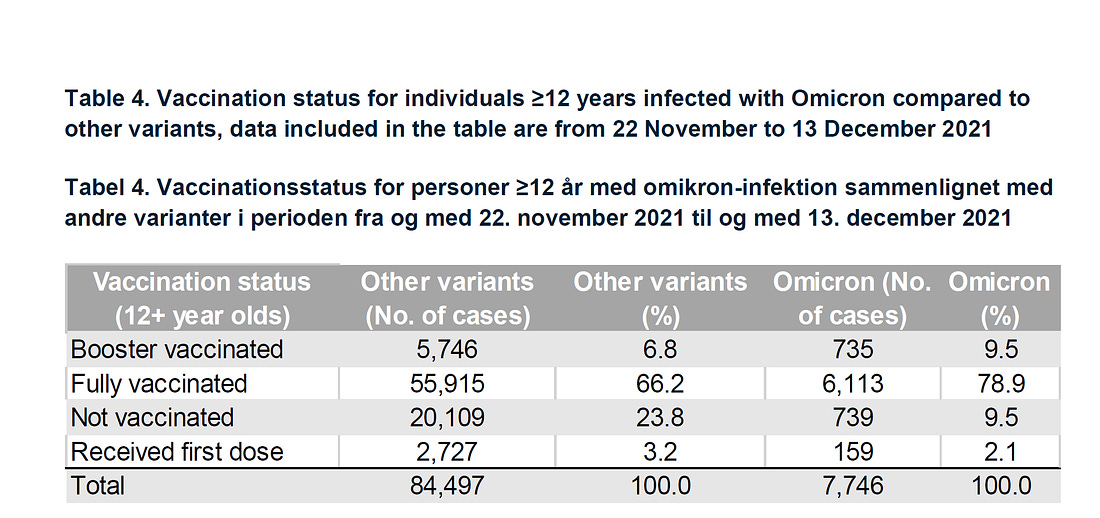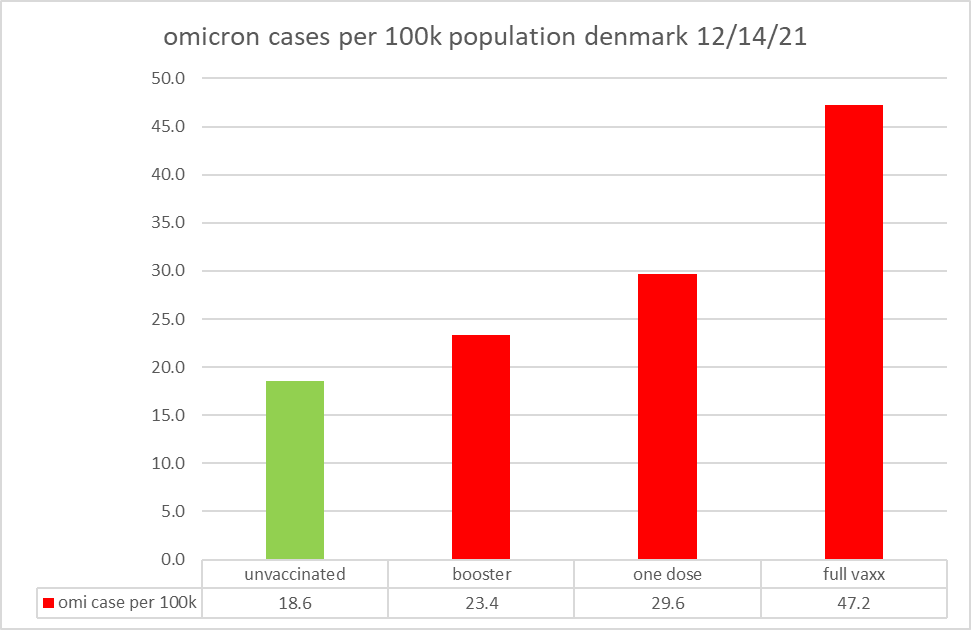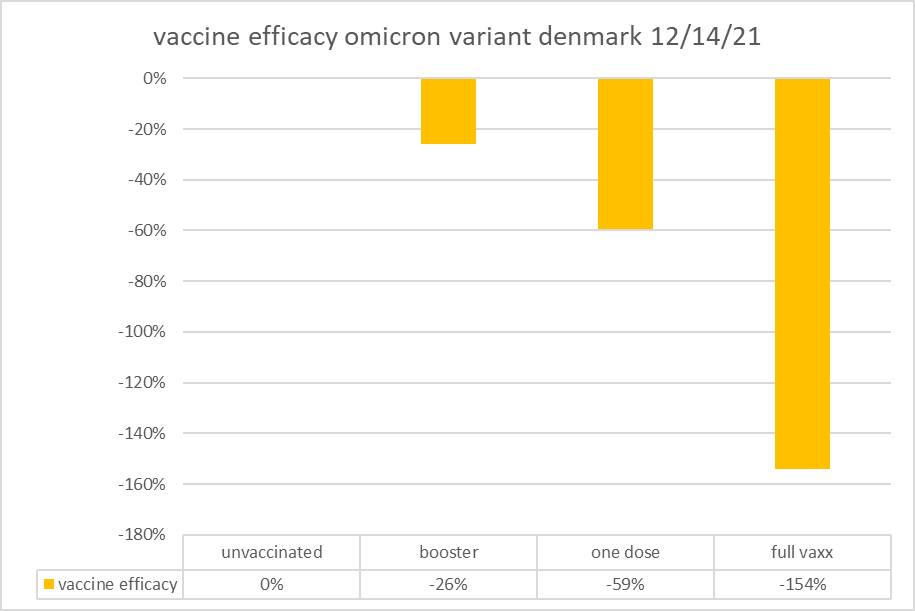there's something antigenic in denmark: boosters show negative vaccine efficacy for casesdenmark has begun providing very specific daily case counts split out for the omicron variant. i think many are misinterpreting this data due to an idiosyncrasy of how it is presented. below i will address this issue and provide what i believe is a way to mitigate it.
cliff notes:
vaccines, including boosters are showing strong negative efficacy vs omicron
this is consistent with omicron being as OAS enabled escape variant
omicron continues to show evidence of mildness relative to past variants
for this analysis, i relied upon the danish national data published HERE and HERE.
for % vaccinated by date, i relied on our world in data HERE
the key danish data is this:

from it, many have made claims like: OMI is 78.7% in the fully vaxxed and yet they are 77.5% of the population, thus, there is no efficacy. similarly, claims of boosters are 10.3% of cases yet the boosted are 25% of the population, thus boosters ARE working vs omi are being made.
unfortunately, neither and especially the latter can be supported by this data. the problem lies here in the fact that the data is aggregated since nov 22.
boosters were only about 10% then. this huge change in prevalence (especially given the rate of change in boosters) makes normalization across the period impossible, especially as overall disease prevalence varies as well. thus, comparing 10.3% to 25% is meaningless

we can get around this issue by slicing the data more finely. to this end, i took the data from the prior day’s report which was through dec 13

we can then subtract this data from the next day’s data and, voila, we have the data for a single day.

this, of course, tells us nothing about vaccine efficacy without knowing the vaccine prevalence, but having narrowed this down to one day, we can now extract a value from OWID. i used 12/14 which will maximize the likelihood of showing a vaccine efficacy signal by using the highest possible base population. (this is almost sure to overstate efficacy as the actual contagion was likely a week or so before the report but as this is impossible to calculate with precision and just adds new error and assumption, i’d rather give all benefit of doubt to vaccines)
from this, we can then calculate VE by normalizing each case count to the size of the relevant sub-population. for convenience sake, i then normalized them to “per 100k population.”
and we get this:

from which we can calculate vaccine efficacy (VE)
 this are, clearly, NOT good numbers. fully vaxxed more than doubles your relative chance of contracting omicron.
this are, clearly, NOT good numbers. fully vaxxed more than doubles your relative chance of contracting omicron.
booster appears to mitigate this, but a lot of that benefit may be illusory because of the benefit we gave it by choosing to use the 25% boosted figure from 12/14. if we use the figure from a week earlier when contagion likely occurred it drops to 18% boosted which, in turn, drops VE to -75% and we get this:
so that looks to be the reasonable range to consider:
based on this data, those vaccinated and boosted have between a 26% and a 75% greater chance than the unvaccinated of contracting omicron. (though, at least it’s a little better than the whopping 154% increase in risk for the double vaxxed though how durable that proves to be is anyone’s guess…)this data, while not dispositive, is strongly consistent with and supportive of omicron as “the variant that leaky vaccines with overly narrow immuno-training begat.” this is OAS. this is exactly the the outcome you’d expect from pinned and non-adaptive immune system training and not what you’d see from simple full vaccine escape.simple vaccine escape would result in ~0% vaccine efficacy. but this looks like vaccines are making the virus MORE infective (as we saw in so much UK data). that’s going to be either OAS or ADE, and i’m nor really seeing the signs of ADE (like higher severity) while many of the markers of OAS (like failure to generate N-protein antibodies).this is, if not a smoking gun, at least quite a warm one. (alas, unlike what john lennon promised us, it brings no happiness. this is very much the outcome that no one wanted.)
jeez, don’t you have any good news?
well, actually, yes.
some perspective:of course, this is not as horrific as it looks when you look at absolute risk increase. double vaxxed is 0.047%, up from 0.0186%. this is not exactly “holy moly, grab my bio-bunnysuit!” territory.
and, of course, that’s cases, not anything inherently severe.
of interest, deaths in denmark look to be dropping as omi spreads, reinforcing once more that omi is a much milder variant. all data i have seen imply this is true among vaccinated and unvaccinated alike. this implies it’s a property of the pathogen, not the inoculant, and this is born out by the sudden drop in deaths as it propagates. presuming this holds, this is what you want, it’s nature making a vaccine and a variant going fully endemic, mild, and becoming another common cold. to be sure, this data has significant limitations.
to be sure, this data has significant limitations.it is society scale and non-randomized. we have no idea what selectors are being applied to the risk groups and how they, on balance, generate risk bias. perhaps the vaxxed and boosted skew old and so do cases, but based on this, it does not seem to be the case for omicron.

perhaps the unvaxxed are generally sicker and higher risk for covid. perhaps they are more likely to have already had covid and thus be at lower risk. this one has been very hard to balance out anywhere and i doubt if anyone knows the answer to any degree of precision.
it’s also new data to me from a new source and we sliced it very thin as this is a young series. i’ll look to update it and track this further and see if we can tease out any further confounds over timeframe and possible simpson’s paradoxes by age, risk etc.
as ever, we do the best we can with the data we have, and the data is a bit of a mess, but
at least the danes look to making an effort at real and honest reporting, which is more than one can say for the US data. 












